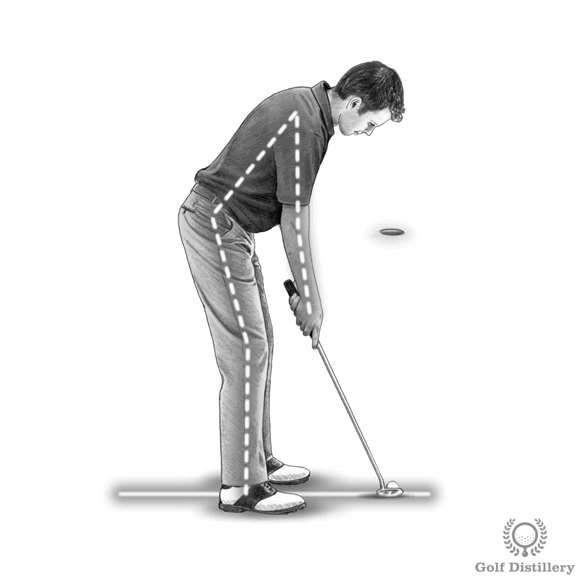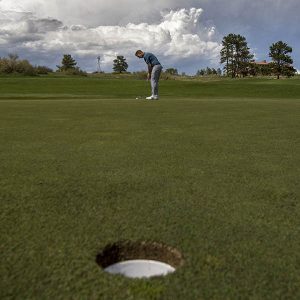3 Little Changes To Stop 3 Putting and Dramatically Lower Your Score!
Today’s post is written by Mike Duhamel. Mike is a Class A, PGA of Canada Performance Coach based at the Haggin Oaks Golf Complex in Sacramento, CA. He has been coaching for 20 years and in that time has worked with some of the top players, coaches, and teams in the game of golf. His coaching consists of a holistic training system developed for athletes who want to challenge their potential.
Putting is the smallest motion that we’re going to make on the golf course, and people often make it a lot harder than it needs to be.
There’s a lot of wrong information out in the world today about putting. Everyone says it’s your own individual thing, but ultimately that is because they don’t understand the science or the laws of the pendulum.
There are actually three large movements that affect people’s putting performance and if you can get all of them honed in then you will be well on your way to putting like the pros!
1.) Set Up and Posture

The first one is the set up and posture.
Your posture is going to dictate how the putter moves, whether it’s efficient, or inefficient.
The body to me is the driving engine of the stroke and that doesn’t change for any other club in the bag.
No matter which club you are swinging, your posture and set up (which determines the motion of the club) are going to dictate how well you hit it!
Therefore your body and the structure of the body are really important in how you set up.
Most people that come to see me don’t have the most efficient posture when they set up for putting.
They are either too far over the ball, or they aren’t bending at the right points, or there are a number of other factors that many golfers don’t realize are throwing them off balance and out of whack.
So the number one thing that you can do for your posture is to work on your balance, and have a system for posture and setup so that you’re getting into the same place each and every time.
This will allow you to increase your performance with a focus on how the putter moves as well as how you’re stroking the putt and what you’re doing with the stroke itself.
2.) Movement

The second thing we want to focus on is how we move the putter.
What most people don’t know is that there’s an ideal time, or tempo, for the putter to move from the time you start your stroke, the first takeaway, to the final impact with the golf ball.
That’s actually what tempo means. The tempo is all about pace – it’s all about the timing.
So how much time does it take me to complete my backstroke and how much time does it take me to complete my forward stroke?
The relationship between those two times is what tempo is and the best players in the world actually have a certain timing pattern to their putting stroke.
Ultimately, the tempo ratio that you are going after needs to be 2:1.
You want your forward stroke to be half the amount of time as your backstroke.
Most people don’t repeat that time and tempo so they struggle greatly with their distance control on the greens.
Knowing that is ultimately the name of the game in putting is figuring out your distance control, as well as your directional control.
That leads me to my third point, which are those two exact things.
3.) Distance/Directional Control

Your distance and directional control are ultimately the causes of the feared three-putt, or worse than that, the four or five putt!
And the reason that so many golfers experience this is because they can’t get it to go the right distance, direction, or both! (we’ve all been there, it’s ok to admit it!)
This is because they change the time (or tempo) in which their stroke happens on every putt.
To go back to the second point about timing and tempo, the goal with putting is to repeat the ideal time for every putt on the putting green, whether it’s three feet, 13 feet, 30 feet, or 60 feet, your stroke is happening in the same amount of time.
What changes is your stroke length, because you need to hit it further or you need to hit it shorter and your clubhead speed changes.
The same thing goes for the full swing, that’s the trick to your distance control.
Golfers also struggle with their direction because their clubface is opening and closing if you want to think about it that way. It’s opening and closing in a certain amount of time, right?
So, it’s moving on an arc.
And when you’re not repeating that time then your clubface is in a different position all the time when you are making contact with the ball.
So the two major results of having the poor time and the poor tempo are that your directional control and distance control suffers.
Ultimately people need to get away from thinking or obsessing about positions in any motion that they make in golf, especially with the putter, and instead think about it as an uninterrupted motion.
If you can work on repeating your timing and knowing the ideal time to move the putter is very important because that’s ultimately going to dictate your putting performance.
It’s not your direction or your clubface being one degree open or two degrees closed, instead focus more on the motion itself and a consistent tempo and everything else will fall into place.

